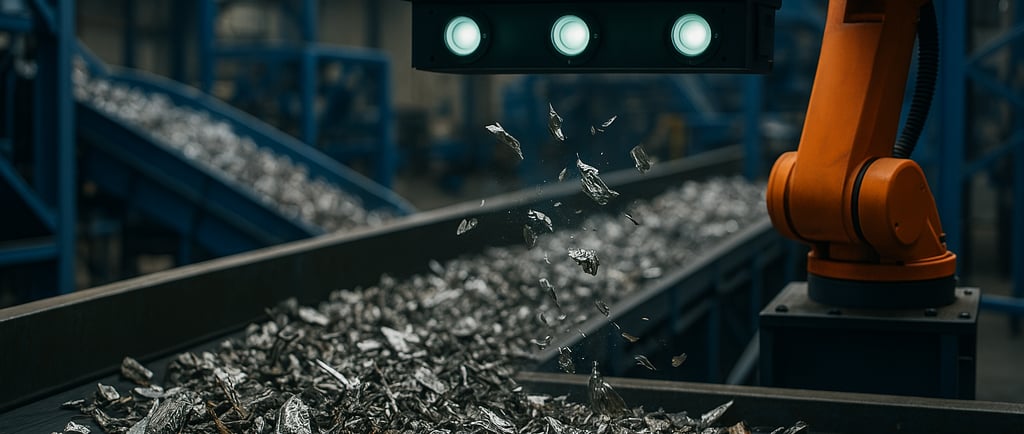The Rise of AI-Powered Metal Sorting and Smart Logistics in North America’s Recycling Industry
Discover how AI-powered metal sorting, IoT-driven logistics, and blockchain transparency are revolutionizing North America’s recycling industry. Explore cutting-edge technologies boosting metal recovery rates, slashing emissions, and transforming waste into economic value—while empowering workers and communities. Dive into the future of sustainable resource management and the race toward a zero-waste world.
SUSTAINABLE METALS & RECYCLING INNOVATIONS


The global recycling industry is undergoing a profound transformation, driven by environmental urgency, technological innovation, and shifting economic priorities. In North America, advancements in AI-powered sorting systems and smart logistics platforms are reshaping metal recycling, addressing inefficiencies in traditional processes while aligning with circular economy goals. This article explores how cutting-edge technologies are revolutionizing the sector—from material classification to supply chain optimization—and the broader implications for sustainability and economic growth.
Table of Contents
The State of Metal Recycling in North America
AI and Automation: Redefining Metal Sorting
Smart Logistics: IoT, Blockchain, and Predictive Analytics
Case Study: AI-Driven Recycling in Action
Environmental & Economic Benefits of Tech-Driven Recycling
Scaling Innovation: Global Adoption and Future Trends
The Human Impact: Workforce Transformation and Community Revival
1. The State of Metal Recycling in North America
North America’s metal recycling sector processes over 130 million metric tons of materials annually, playing a critical role in sustainable resource management. Yet, persistent challenges hinder progress:
Outdated Sorting Methods
Manual labor and electromechanical systems (e.g., magnetic separators) struggle with accuracy, especially for complex scrap like EV batteries and e-waste.
Contamination Issues
Improperly sorted materials reduce the value of recycled metals and increase downstream costs.
Regulatory and Market Pressures
Stricter waste management laws, resource scarcity, and corporate ESG commitments are pushing the industry toward tech-driven solutions.
2. AI and Automation: Redefining Metal Sorting
Artificial intelligence is addressing legacy inefficiencies through precision and scalability:
Multi-Sensor Fusion
Hyperspectral imaging, X-ray fluorescence (XRF), and machine vision analyze materials at atomic levels, distinguishing alloys with 98%+ accuracy.
Deep Learning Models
Trained on vast datasets, these systems classify metals in real time, even identifying rare composites.
Robotic Sorting
Automated arms and pneumatic ejectors process materials at 60+ picks per minute, tripling throughput compared to manual methods.
Impact
Traditional purity rates (70–80%) jump to 98.7% with AI.
Energy use drops by 70%, slashing emissions.
Advanced systems now handle previously non-recyclable materials, such as mixed e-waste.
3. Smart Logistics: IoT, Blockchain, and Predictive Analytics
Beyond sorting, tech innovators are optimizing the entire recycling chain:
IoT Tracking
Sensors monitor scrap quality, location, and environmental conditions (e.g., temperature for copper transport).
Dynamic Routing
Machine learning reduces empty truck miles by 35%, cutting costs and emissions.
Blockchain Marketplaces
Transparent platforms connect suppliers, recyclers, and manufacturers, automating contracts and ensuring fair pricing.
Predictive Demand Forecasting
Algorithms align scrap processing with industrial needs (e.g., lithium for EV batteries), minimizing stockpiles.
4. Case Study: AI-Driven Recycling in Action
Client: A North American EV Manufacturer
Challenge
Inconsistent aluminum quality from traditional recyclers caused production delays.
Solution
AI sorters deployed at partner scrap yards to pre-process end-of-life vehicles.
IoT trackers ensured material purity during transit.
Predictive analytics synchronized scrap supply with manufacturing cycles.
Results
98.5% purity in recycled aluminum, meeting aerospace standards.
25% cost reduction vs. virgin materials.
12,000 metric tons of CO₂ saved annually.
5. Environmental & Economic Benefits
Environmental Wins
Resource Conservation: Recycling 1 ton of steel saves 1.5 tons of iron ore.
Emission Reductions: AI sorting cuts energy use by 70%, aiding corporate net-zero goals.
Landfill Diversion: Advanced systems recover 95%+ metals from complex waste streams.
Economic Value
Recyclers see 50% faster throughput and 30% higher revenue from premium pricing.
Manufacturers save millions using recycled metals (e.g., $1.2M/year on silver for solar panels).
Job Creation: High-skilled roles in AI maintenance and data analytics offset manual labor displacement.
6. Scaling Innovation: Global Adoption and Future Trends
Tech-driven recycling is expanding worldwide:
Europe
AI sorters help achieve EU mandates for 95% end-of-life vehicle recyclability by 2030.
Asia
Portable systems recover gold from e-waste, while blockchain platforms integrate informal recyclers.
Localized Solutions
Algorithms adapt to regional scrap types, like Southeast Asia’s motorcycle parts.
Future Vision
Smart Cities: Embedding AI sorters in municipal waste streams.
Material Passports: Blockchain tracking for cross-industry reuse (e.g., aircraft aluminum repurposed for EVs).
Policy Advocacy: Lobbying for global recycling standards and subsidies for clean tech adoption.
7. The Human Impact: Workforce Transformation and Community Revival
Upskilling Workers
Training programs transition manual sorters to roles in robotics and data analysis.
Example: A 12-year sorter in Texas became an AI operations manager, tripling her salary.
Community Revitalization
Former industrial hubs (e.g., Ohio’s Rust Belt) reopen as tech-driven recycling centers, creating hundreds of jobs.
Developing regions (e.g., Ghana) transform e-waste dumps into safe recycling zones, funding schools and clinics.
Environmental Justice
Mobile AI systems reduce toxic scrap burning in pollution-burdened areas like Louisiana’s “Cancer Alley.”
Conclusion: Toward a Zero-Waste Future
The fusion of AI, IoT, and blockchain is proving that sustainability and profitability can coexist. Key milestones by 2030 include:
10M+ tons of material processed annually via advanced systems.
20M metric tons of CO₂ emissions avoided.
100,000 workers trained in green-tech roles.
As industries and governments embrace these innovations, the vision of a circular economy—where waste is obsolete and resources perpetually reborn—grows increasingly attainable. The future of recycling isn’t just about technology; it’s about building a world where every scrap of metal fuels progress for people and the planet.
